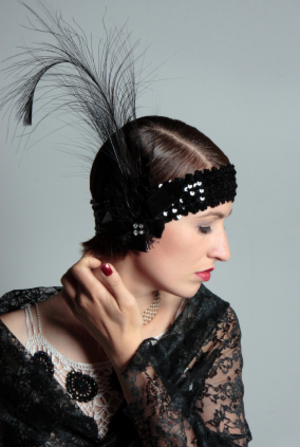The 1920’s was a time period of diverse change in American History. World War I had ended and people were feeling free spirited, women were given the right to vote, and the prohibition movement began. Amongst all of the changes that took place during this era, one vivid image stands out from the rest, that being the image of the flapper.
The flapper fashion statement did not actually debut until 1926. The typical flapper girl had very short but sleek hair, wore an above the knee straight shift dress, and had a boyish figure. She also demonstrated her rebellious side by smoking long cigarettes in public, applying make-up in public and dancing the night away with her bare limbs exposed. The shift style, waistless flapper dress itself was relatively easy to make at home, which allowed the middle class women to blend in with the highly fashionable upper class. The flapper fashion era lasted from 1926-1928.
Clothing
In the early 20’s waistlines were at the hip and hemlines were calf length. As the decade progressed the waistline dropped below the hip and then disappeared in the flapper era as the hemlines went up. In 1928 hemlines became uneven and asymmetrical as they shifted back to the longer skirts and dresses. Women threw the corsets out and adopted a more comfortable style of clothing. Gabrielle Chanel, better known as Coco Chanel, was the fashion designer of the era whose fashions epitomized the look of the 20’s. She designed simple outfits but added accessories.
Accessories
Even though the clothing designs of the era were more comfortable the feather boas, embroidery, and accessories of the time complemented them. Hats were a popular women’s accessory during the 1920’s. In the early part of the decade ladies opted for simple hats with brims. The rimless cloche hat became popular in 1925. The close fitting cloche hat was only wearable with a short and flat hairstyle. This hat also impacted women’s posture in the 20’s as it was pulled over their eyes, so it was necessary for ladies to tilt their heads in order to see where they were going.
Another popular accessory in the 20’s were patterned stockings. Some stockings even featured embroidery from the ankle to the knee. Both flesh and pastel colored stockings made from silk or rayon were popular. In order to play down the shine produced by rayon stockings, ladies would powder their legs.
Speaking of powder, the use of make up was on the rise in the 1920’s. Instead of running off to the ladies room to apply lipstick or powder, ladies would do this in public. Lipsticks were bright red and applied freely, but rouge was applied lightly.
Footwear
It was during the 1920’s that shoes began to be mass-produced. Those Mary Jane shoes that are still worn today became popular in the 1920’s. With the rising hemlines, more attention was paid to shoes. Heels that were over 2 inches high were popular at the time as well as the two-tone shoe designed by CoCo Chanel. Additionally, it was quite common to find shoes adorned with sequins or diamante trims
Outerwear
Coats of the first half of the decade were long to match the hemlines and belted. Another very popular style coat was the wrapover. All coats seemed to wrap to the right and included a large fastener of some sort, a button, tab, or buckle. Many coats also featured fur shawl collars and lining that coordinated with a dress.
Hair
The most popular hairstyles of the early 1920’s was a short bob and most ladies were seen with some type of bangs since foreheads were unfashionable in the 1920’s. During the roaring twenties, as women became bolder and hemlines became shorter, so did their hair. The severe Eton Crop of 1926 is the style seen on many flappers. Since hair had always been considered one of the most important features of a woman, older ladies considered adapting the short Eton Crop very daring.
Sources:
http://en.wikipedia.org/wiki/1920s_in_fashionhttp://en.wikipedia.org/wiki/1920s_in_fashionhttp://www.fashion-era.com/flapper_fashion_1920s.htm
